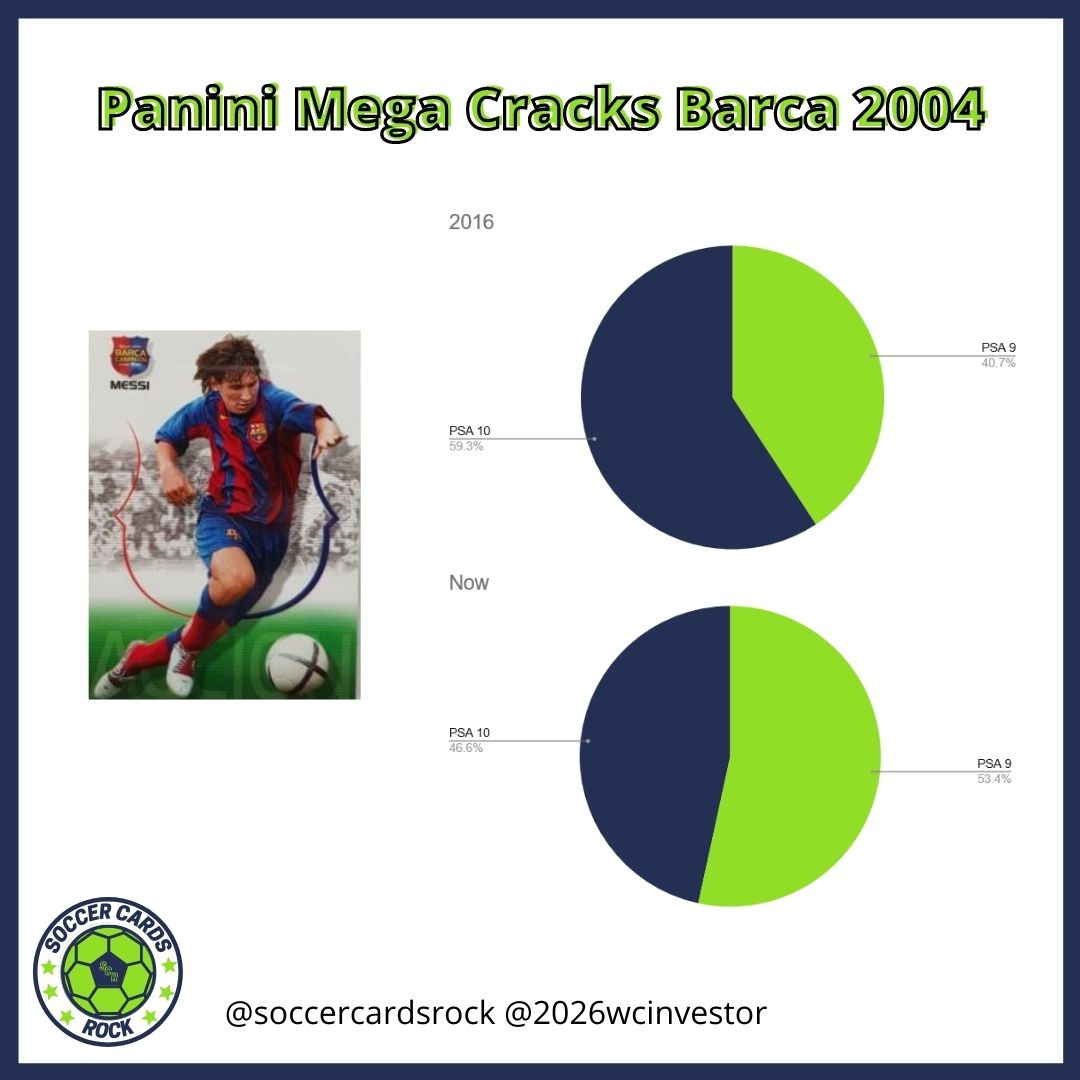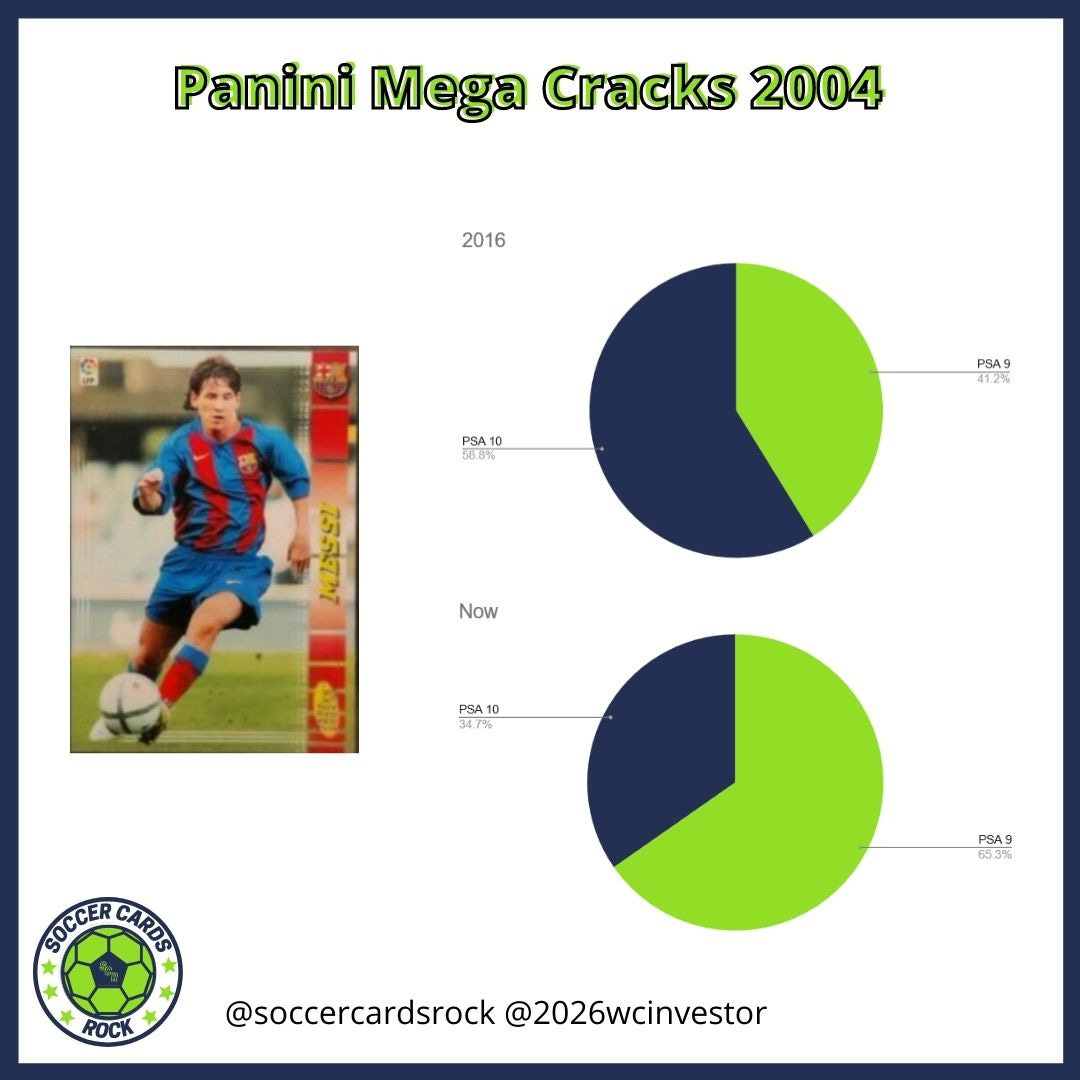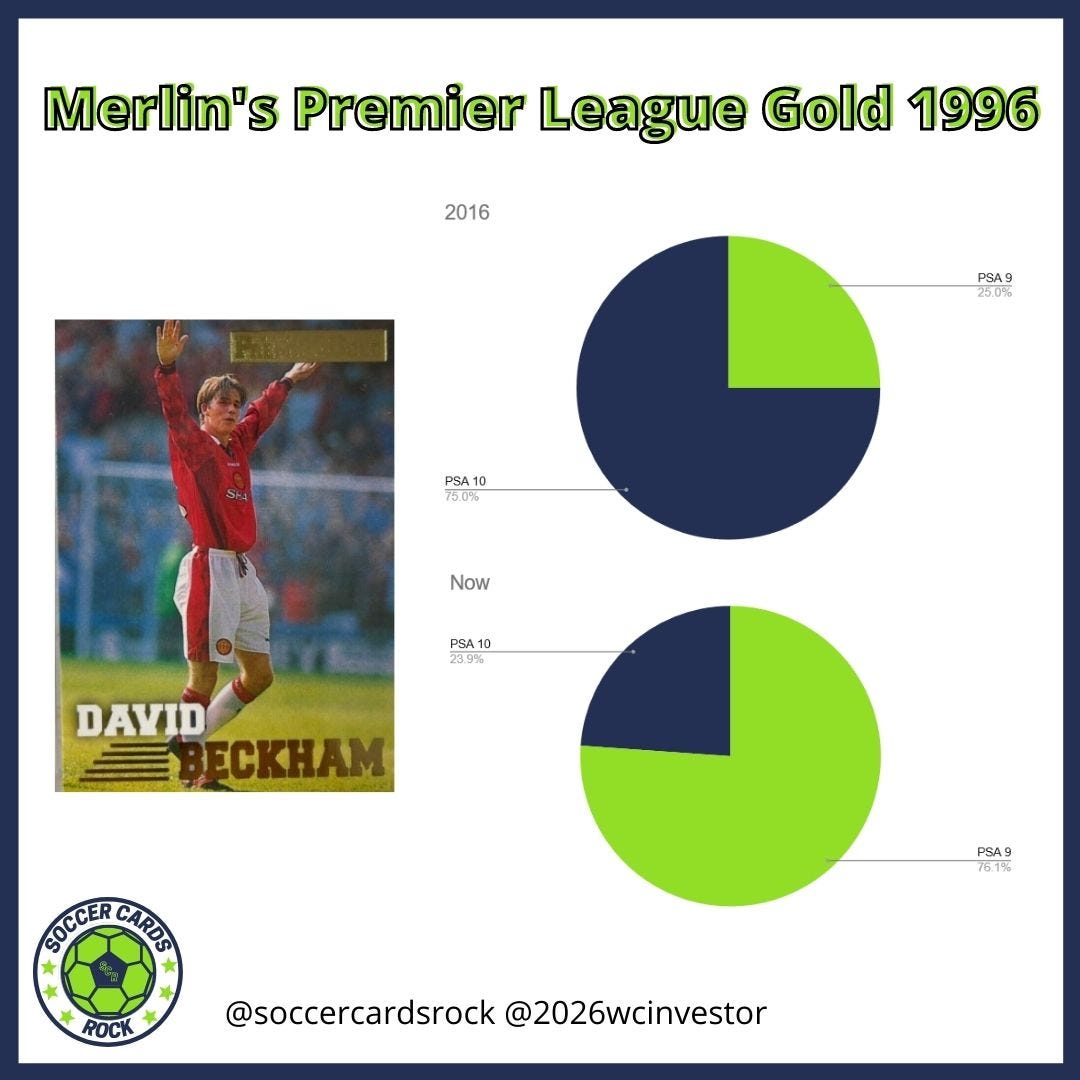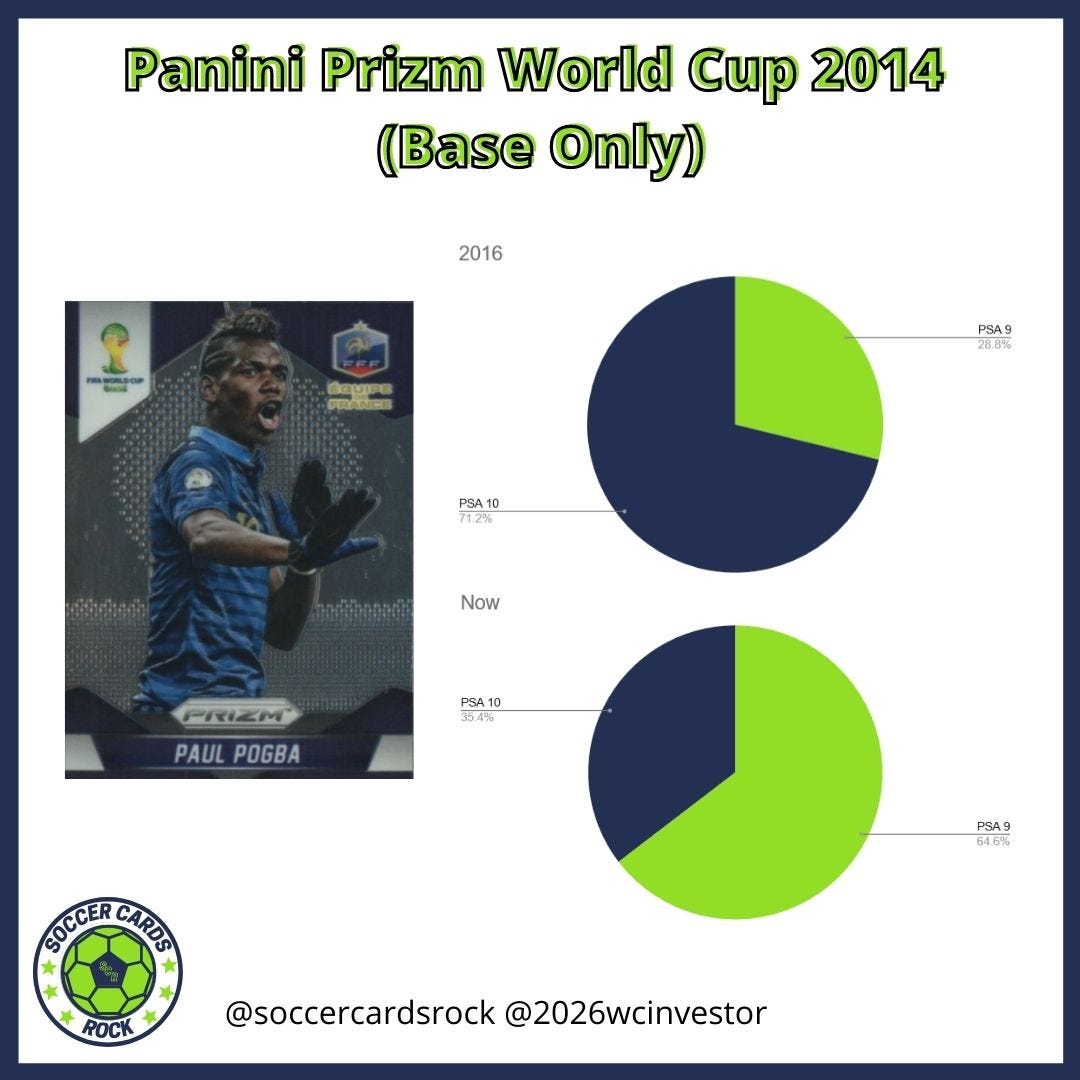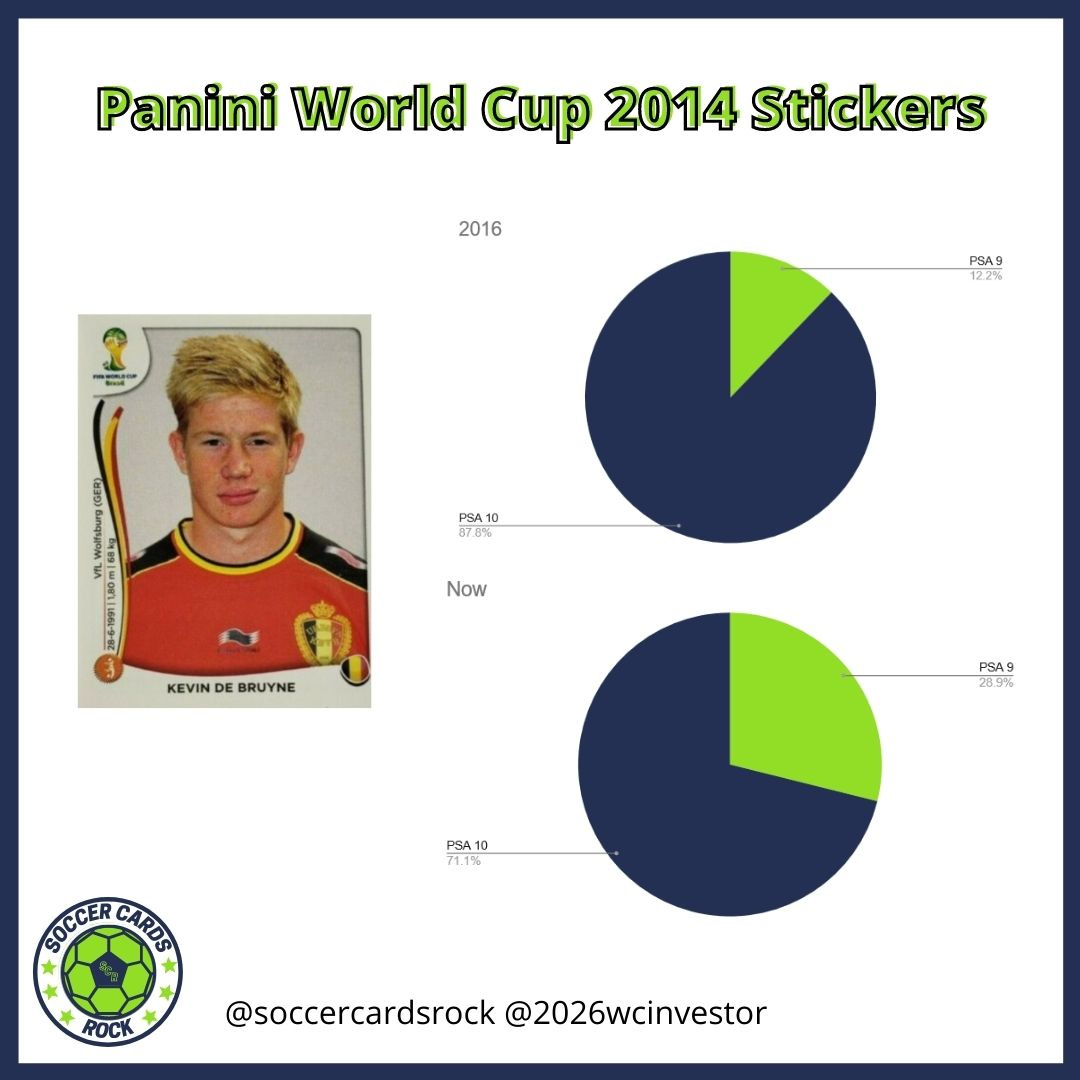Is it Easier To Get a PSA 10 When You Grade Early: A Case Study (Part 2)
Welcome back!
This two-parter is all about the frequency that mint graded cards are given a PSA 10 compared to a PSA 9 over time.
In yesterday’s newsletter we set up the pins… now let’s see how they land.
The Results
Panini Mega Cracks Barca 2004
The first set I looked at was the Barcelona Mega Cracks set - most well known for featuring three key Lionel Messi rookie cards.
There's two sets of these, however the 2016 data lumped everything in together from what I could see, so I just used that and the more popular Spanish set as it's comparison.
Here are the results.
In 2016, there were 81 mint cards that received a PSA 9 or a PSA 10. Of which, 48 were a PSA 10. Yep... there were more PSA 10s than there were 9s. In fact, about 60% of the mint cards were a PSA 10.
These days, there has been a turnaround - out of the 704 mint cards, 328 are a PSA 10, down to about 45%.
That's quite a large turnaround considering the sheer amount of cards graded and with more and more cards from this set getting sent in, it'll be interesting to see how it compares.
Panini 2004 Mega Cracks La Liga
While the Barca Mega Cracks has some Messi rookies, the big boy Messi card is the La Liga Mega Cracks set.
In my opinion it's one of the top three cards in the entire soccer card hobby, and I think it'll eventually make it's way into the top five or ten in the entire sports card hobby over time.
With that in mind, here are the mint results in 2016 and now.
In 2016, there had been 34 cards in the entire set that were graded a mint 9 or 10 - and out of those, 34 were a PSA 10.
Since, there's only been another fourteen PSA 10s added, with another fifty PSA 9s.
There's an awful lot of movement there!
That's a turnaround from nearly 60% PSA 10s, to only around about 35%.
Crazy stuff!
Panini Mega Craques 2003
The 2003 Mega Craques set features Cristiano Ronaldo's rookie card as it's main card. The card itself hasn't been as well sought out compared to the Messi rookie - although at the time of writing that has been changing a little and the Ronaldo is getting more love.
Let's take a look at the stats.
This set has been the one with the most consistency when looking at the grades of mint cards.
In 2016, the ratio was eight PSA 9s and twenty-five PSA 10s, meaning that around about 75% of mint cards were 10s.
These days the percentage of 10s has dropped but not significantly. Currently, it's sitting at around 68%. Like I said, a drop, but nothing too big - there's still more PSA 10s in the set then there are PSA 9s!
I really wonder what this set looks like going forward and if it'll continue to stay at this rate.
And with that, I wonder if the price gap between the 9 and the 10 will be less than other key cards in the hobby.
Merlin's Premier League Gold 1996
This set is a little bit interesting because we can look at the data for the key card in the set!
The key card in the Merlin 1996 Premier League Gold set is a main David Beckham rookie - and it also happens to be the only card in the set graded as of the time of writing.
So this is an analysis of the Beckham card and the entire set all in one (talk about bang for your buck).
Another massive difference in this data.
With the first four mint Beckham cards sent into PSA, three of them were graded a PSA 10. Since then, there's been another 63 cards get a mint grade, and fifty of them have been a PSA 9 with only another thirteen getting a PSA 10.
That's basically going from 75/25 to 25/75!
Granted, the four cards to begin with is a tiny sample size, but it's interesting to see the sheer number of 9s that have come up since then.
Panini Prizm World Cup 2014 Base
I don't know if I'm burying the lead by putting Prizm this far down, but I wanted to keep it in chronological order.
The Prizm World Cup set has proven to be one of the biggest sets in the hobby. While it wasn't Messi or Ronaldo's first World Cup (that was the 2006 World Cup), it was the first "Prizm", which I guess means something - along with being the first World Cup for a lot of other great players.
For this I'm only looking at the base cards - with all the different parallels it would be death by pie chart.
Again, in 2016 there were more PSA 10s than there were PSA 9s, and by quite a few too! About 70% of the total mint graded cards were a PSA 10 in 2016, compared to about 35% at the start of 2021.
That's a massive drop off considering there was nearly 8500 cards get mint graded since then. I don't think I expected a change like that - I was definitely expecting more 9s than 10s in 2016 considering people talk about how hard the surfaces of Prizms can be to get 10s on - even straight from the pack.
Panini World Cup 2014 Stickers
I wanted to include a set of stickers in this analysis because it's lore that stickers are super hard to get high grades.
I originally wanted to use the 2006 World Cup sticker set, but there were far more 2014 stickers graded in the 2016 data, so I thought that would give a better look.
Well.... there's more PSA 10s than there are PSA 9s, which puts the whole sticker thing to bed for that set anyway (it's a fact that looking at card vs sticker grading, stickers are way harder to grade overall).
In 2016, of the 41 stickers that received a mint grading, thirty-six of them got a PSA 10! That's 88%, which is incredibly impressive.
That number has dropped since then, and at the time of writing, about 70% of stickers that got a mint grade received a 10.
I didn't expect to see the stickers to grade with more 10s than 9s, and it'll be interesting to see how that number goes over time. There's some key players in this era that had a debut World Cup in 2014, so the set will have some legs long-term.
The Verdict
Looking at this, you can definitely notice a trend that a mint grade is more likely to get a 10 opposed to a 9 the earlier it's graded.
Out of the six sets we looked at, each one of them decreased in how frequently a PSA 10 is awarded.
In total, adding all the numbers from all six sets, in 2016 about 70% of the mint cards received a PSA 10, with 30% getting a PSA 9.
These days, the percentage of PSA 10s has halved, with around 35% of mint cards getting the PSA 10 label.
Does that mean that PSA are adjusting the market of PSA 10s once a card becomes popular? I wouldn't say that for sure, there's multiple other factors that could come into play here (I'll talk about those below).
Looking at these numbers though it's impossible to argue that in 2016 more mint cards were given a PSA 10 grade compared to a PSA 9 and now that isn't the case.
It will be very interesting to see if this gap widens over time.
Other Reasonings and Potential Rebuttals
Like I said, there's some obvious alternative explanations and potential rebuttals here:
More people are grading cards these days
Back then, people only graded if they knew the card would be a 10
The cards were newer, so there's obviously going to be more 10s
However, I don't really see those as too big of a case - in this case study, we're only looking at the cards that were mint graded. The total number of cards, or the age of the cards shouldn't matter - we're simply seeing how PSA compare mint graded cards against one another.
For me, the biggest rebuttal is due to the sample size. I've only looked at six sets from the entire PSA selection. When you consider the sheer amount of cards PSA have graded, we haven't even scratched the surface.
I wouldn't say it looks good though...
Way to Improve this Study in the Future
I think the best ways to build upon this study going forward would be:
Look at sets from various sports, the soccer card market is still so young compared to others
Looking at more sets in general - the more data points the better
The ability to compare key cards in the set to others. Do Messi 2004 Mega Cracks rate at the same rate as other cards in the set?
Hopefully PSA open up the ability to look at historical data and show trends over time
My Key Takeaways
PSA need a way to include some transparency in their historical data
Are there set parameters that separate a 9 and a 10? The standard is pretty hard to argue because it's seemingly so vague.
The soccer market is still so young - the number of these graded cards is so tiny compared to other sports
Worst case scenario, even if you think this is all BS - there was some handy graphs. And now you know how to do something similar yourself.
Your Next Steps
Subscribe to the newsletter if you haven’t
Share this article with someone else in the hobby
Want to read the entire post - read it here.





